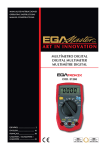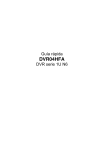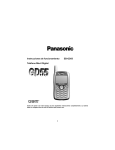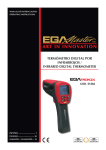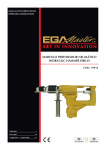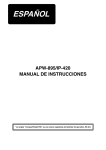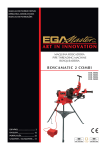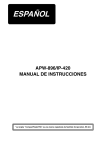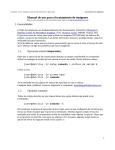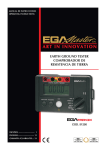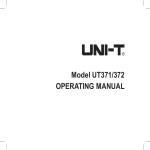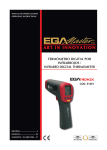Download PINZA AMPERIMÉTRICA / CLAMP METER /
Transcript
MANUAL DE INSTRUCCIONES OPERATING INSTRUCTIONS PINZA AMPERIMÉTRICA / CLAMP METER / COD. 51247 ESPAÑOL................................ 2 ENGLISH............................... 20 GARANTIA/GUARANTEE...... 39 ESPAÑOL TABLA DE CONTENIDOS Información general........................................................................................................... 3 Desembalaje..................................................................................................................... 3 Información de seguridad................................................................................................... 3 Reglas para un uso seguro.................................................................................................. 4 Símbolos eléctricos internacionales.................................................................................... 5 Estructura del Medidor....................................................................................................... 5 Botones funcionales........................................................................................................... 6 La efectividad de los botones funcionales........................................................................... 6 Símbolos de la pantalla....................................................................................................... 7 Operación de medida...................................................................................................... 8 A. Medición de tensión DC/AC..................................................................................... 8 B. Medición de resistencia............................................................................................. 8 C. Prueba de continuidad.............................................................................................. 9 D. Prueba de diodos.................................................................................................... 10 E. Medción de frecuencia............................................................................................. 11 F. Medción del ciclo de trabajo.................................................................................... 12 G. Meddición de corriente DC/AC .............................................................................. 12 Modo “sleep”................................................................................................................... 13 Especificaciones............................................................................................................... 13 A. Especificaciones generales...................................................................................... 13 B. Requerimientos ambientales.................................................................................... 14 Especificaciones de precisión........................................................................................... 14 A. Tensión DC............................................................................................................. 14 B. Tensión AC ............................................................................................................ 14 C. Resistencia.............................................................................................................. 15 D. Prueba de diodo..................................................................................................... 15 E. Prueba de continuidad............................................................................................. 15 F. Frecuencia............................................................................................................... 16 G. Ciclo de trabajo...................................................................................................... 16 H. Corriente DC ......................................................................................................... 16 I. Corriente AC........................................................................................................... 17 Maintenimiento................................................................................................................ 17 A. Servicio general...................................................................................................... 18 B. Sustitución de la batería.......................................................................................... 18 2 INFORMACION GENERAL Este manual de instrucciones contiene información sobre seguridad. Por favor lea atentamente la información relevante y observe todas las advertencias y notas de manera estricta. ¡Advertencia! Para evitar descargas eléctricas o daños personales, lea la “información de seguridad” y “Reglas para la operación segura” atentamente antes del uso del medidor. La Pinza Amperimétrica Digital Modelo COD. 51247 (en adelante “El Medidor) es un instrumento de medición altamente fiable, de operaciones estables, con dígitos de 3 3/4” y estructura moderna. El Medidor puede medir tensión AC/DC, corriente AC/DC, Frecuencia, ciclo de trabajo, resistencia, diodos, continuidad, etc.El Medidor no sólo es capaz de medir Tensión AC/DC, Corriente AC/DC, Frecuencia, Ciclo de Trabajo, Resistencia, Diodos, Continuidad sino que también dispone de función de Retención de Datos, Modo “SLEEP”, y modo Características adicionales. DESEMBALAJE Abra el paquete y saque el medidor. Compruebe atentamente los siguientes elementos para visualizar cualquier parte dañada o posible falta de material. Artículo Descripción Cantidad 1 Manual de instrucciones 1 pieza 2 Cable de prueba 1 par 3 Maletín 1 pieza 4 Batería 9V (NEDA1604, 6F22 or 006P) 1 pieza En el caso de encontrar algún daño o falta de material, por favor póngase en contacto con su distribuidor inmediatamente. INFORMACION DE SEGURIDAD Este Medidor cumple con los estándares IEC61010: en grado de contaminación 2, categoría de sobretensión (CAT II 600V, CAT III 300V) y doble aislamiento. CAT II: Nivel local, dispositivo, EQUIPO PORTÁTIL, etc., con menores sobretensiones transitorias que CAT III. CAT III: Nivel de distribución, instalación fija, con menores sobretensiones que CAT IV. Utilice este Medidor sólo como se especifica en este manual, de lo contrario la protección provista en el instrumento podría verse afectada. En este manual, una advertencia identifica condiciones y acciones que representan riesgos para el usuario, o posibles daños al medidor o al equipo bajo prueba. Una nota identifica la información que el usuario debe prestar atención. Los símbolos eléctricos internacionales usados en el medidor y en el manual de instrucciones son explicados en la página 5. 3 REGLAS PARA UN FUNCIONAMIENTO SEGURO Antes del uso del medidor inspeccione la carcasa. No use el medidor si ésta está dañada o la carcasa (o parte de ella) está retirada. Busque roturas o posibles faltas de plástico. -Preste atención al aislamiento alrededor de los conectores. -Inspeccione los cables de prueba por posibles daños en el aislante o partes metálicas expuestas. Verifique la continuidad de los cables de prueba. Remplace los cables dañados por unos de idéntico número de modelo o especificaciones eléctricas, antes del uso del medidor. - No aplique más del ratio de tensión marcado en el medidor, entre los terminales o entre cualquier terminal y la toma de tierra. Si el valor a ser medido es desconocido, use la posición de máxima medida y reduzca el rango poco a poco hasta que la lectura obtenida sea satisfactoria. - Cuando la medición haya sido completada, desconecte la conexión entre los cables de prueba y el circuito bajo prueba, retire los cables de prueba lejos de la entrada de los terminales del medidor y apague el medidor. - La posición del selector giratorio debería estar situada en la posición correcta y sin ningún cambio durante la medición evitando daños en el Medidor. - No lleve a cabo la mediciones cuando la carcasa trasera del Medidor y el compartimento de la batería no estén cerrados para evitar descargas eléctricas. -No introduzca tensiones superiores a 600V entre los terminales de entrada del medidor para evitar descargas eléctricas y daños al Medidor. ¡Advertencia! -Cuando el Medidor trabaje con una tensión eficaz por encima de 60V en DC o 30V rms en AC, se deberá tomar especial cuidado al peligro de posibles descargas eléctricas. -No utilice o almacene el Medidor en un ambiente de alta temperatura, humedad, explosivo, inflamable y fuertes campos magnéticos. La capacidad del Medidor puede deteriorarse después de humedecerse. -Cuando utilice los cables de prueba, mantenga sus dedos tras el protector. -Desconecte la energía del circuito y descargue todos los condensadores de alta tensión antes de testear la resistencia, continuidad y diodo. - Reemplace la batería tan pronto como el indicador de batería aparezca. Con una batería baja, el Medidor puede producir falsas lecturas que pueden conducir a descargas eléctricas o daños personales. - Al reparar el Medidor, use solamente el mismo número de modelo o repuestos de idénticas especificaciones eléctricas. -El circuito interno del Medidor no debe ser alterado para evitar posibles daños al Medidor y cualquier accidente. -La superficie del Medidor debe ser limpiada con un trapo suave y un detergente suave. No deben usarse disolventes ni abrasivos para prevenir la corrosión de la superficie, daño o accidente. - El Medidor el apropiado para uso en interior. -Apague el medidor cuando no esté en uso y extraiga la batería cuando no sea usada durante un largo periodo de tiempo. -Compruebe constantemente la batería ya que puede tener pérdidas cuando haya sido usado durante algún tiempo, remplace la batería tan pronto como las pérdidas aparezcan. 4 SIMBOLOS ELECTRICOS INTERNACIONALES AC (Corriente Alterna) DC (Corriente contínua) AC o DC Toma de tierra Doble aislante Advertencia. Consultar manual de instrucciones. Deficiencia de la batería Prueba de continuidad Diodo Fusible Peligro de Alto Voltaje Conforme con los estándares de la Unión Europea. ESTRUCTURA DEL MEDIDOR (vea figura 1) 1.Terminales de entrada 2.Pantalla LCD 3.Botones 4.Ruleta 5.Gatillo: Presione para abrir la pinza. Cuando la presión sobre el gatillo se libera, la pinza se cierra. 6.Protector de manos: Para proteger las manos del usuario de tocar áreas peligrosas. 7.Pinza: diseñado para tomar la corriente AC y DC que fluye por el conductor. El conductor a ser probado debe pasar verticalmente por el centro de la pinza. SELECTOR GIRATORIO A continuación se muestra información referente a las posiciones que pueden ser adoptadas por el selector. Posición del selector OFF Función Apagado Medición de tensión AC o DC Medición de resistencia : Prueba de diodo Hz / Duty% 40A & 400A : Prueba de continuidad Medición de frecuencia y trabajo. Rango de medición de corriente AC y DC. 5 FUNCION DE LOS BOTONES La siguiente tabla aporta información sobre las funciones de los botones. Botón Operación desempeñada Presione HOLD para entrar en modo retención en cualquier modo, el Medidor sonará. HOLD -Presione HOLD de nuevo para salir del modo retención, el Medidor sonará. En rango y : - Presione para seleccionar modo medición con rango manual. El medidor toma por defecto el modo medición con rango automático. REL - Cuando el Medidor está en modo medición con rango manual, presione para reducir el rango. AEn rango A : - Presione para entrar en modo REL. - Resta un valor almacenado al valor de medición actual y se muestra un resultado. En rango Hz/Duty%: - Presione para alternar entre modo medición Hz y modo medición Ciclo%. -Presione botón SELECT para seleccionar las funciones alternativas marcadas en color azul en la parte frontal inclutendo , , SELECT 40A , y 400A . - Después de que el Medidor entre en Modo “sleep”, presione y mantenga SELECT para encender el Medidor. Esto deshabilitará el Modo “sleep”. LA EFECTIVIDAD DE LOS BOTONES No todos los botones pueden ser usados en cualquier posición del selector giratorio. La tabla de a continuación describe qué botones pueden ser usador con las posiciones del selector. Posición del selector SELECCION REL HOLD - 1 1 N/A 1 1 1 N/A 1 N/A 1 1 40A 1 1 1 400A 1 1 1 Hz / Duty% 6 Botones SIMBOLOS DE LA PANTALLA (vea figura 2) (figura 2) Númbero Símbolo Significado 1 AC Indicador de corriente o tensión en AC. 2 DC Indicador de tensión en DC. Batería baja. Advertencia: para evitar falsas lecturas, que pueden provocar posibles descargas eléctricas o daños personales, reemplace la batería tan pronto como el indicador de batería aparezca. El Medidor está en modo auto rango donde el Medidor selecciona automáticamente el rango con la mejor resolución. 3 4 5 Prueba de diodo 6 Continuidad. Sonido activado. 7 % Indicador para trabajo. 8 Retención de datos activado. 9 Indicador para modo REL. : Ohm. Unidad de resistencia. 10 ,k ,M k M : Kilohm. 1x103 oro1000 ohms : Megohm. 1x106 o 1,000,000 ohms 11 Hz Unidad de Frecuencia. 12 A Amperios. Unidad de corriente. 13 mV, V 14 Voltios. Unidad de tensión mV: Millivoltio. 1x10-3 or 0.001 voltios Indica lectura negativa. 15 TRMS Indicador para modo TRMS. 16 OL El valor de entrada es demasiado grande para el rango seleccionado. 7 OPERACION DE MEDIDA A. Medición de tensión DC/AC (vea figura 3) ¡Advertencia! Para evitar daños personales o daños al medidor provocados por descargas eléctricas, no intente medir voltajes superiores a 600V AC/DC, aunque las lecturas puedan ser obtenidas. Los rangos de tensión en DC son: 400mV, 4V, 40V, 400V y 600V. Los rangos de tensión en AC son: 4V, 40V, 400V y 600V. Rojo Negro (figura 3) Para medir tensiones DC, conecte el medidor de la siguiente manera: 1. Inserte el cable de prueba rojo en el terminal Hz Duty% V VΩHz y el negro en el terminal COM 2.Seleccione con el selector modo V . La medida DC aparece por defecto. Presione SELECT para cambiar a modo medición AC o presione REL para cambiar a modo de medición con rango manual. 3.Conecte los cables de prueba al objeto a medir. El valor de la medición se verá reflejado en la pantalla. Nota: Cuando la medición de tensión DC/AC haya sido completada, desconecte la conexión entre los cables de prueba y el circuito bajo prueba y retire los cables de prueba de las entradas de los terminales. B. Medición de resistencia (vea figura 4) ¡Advertencia! 8 Para evitar daños al Medidor o a los aparatos bajo test, desconecte la energía del circuito y descargue todos los condensadores de alto voltaje antes de la medición de resistencia. Los rangos de resistencia son: 400 , 4k , 40k ,400k ,4M y 40M . Rojo Negro (figura 4) Para probar la continuidad, conecte el medidor de la siguiente manera: 1. Inserte el cable de prueba rojo en el terminal Hz Duty% V y el cable de prueba negro en el terminal COM. 2.Gire el selector hasta . La medición de resistencia viene en auto rango por defecto, presione REL para cambiar a modo de medición a rango manual. 3.Conecte los cables de prueba al objeto a medir. El valor de la medición se verá reflejado en la pantalla. Note: - Para obtener una lectura más precisa, se puede remover los objetos que se están probando del circuito a la hora de medir. - Cuando la medición de la resistencia haya sido completada, desconecte la conexión entre los cables de prueba y el circuito bajo prueba y retire los cables de prueba de las entradas de los terminales. C. Prueba de diodos (vea figura 6) ¡Advertencia! Para evitar daños al Medidor o a los aparatos bajo prueba, desconecte la energía del circuito y descargue todos los condensadores de alto voltaje antes de la prueba de diodos. Use la prueba de diodo para verificar diodos, transistores, y otros aparatos semiconductores. La prueba de diodo envía una corriente a través de la unión del semiconductor, y luego mide la caída de tensión a través de la unión. Una buena unión de silicio cae entre 0.5V y 0.8V. 9 Rojo Negro (figura 5) Para probar el diodo fuera de un circuito, conecte el Medidor de la siguiente manera: 1. Inserte el cable de prueba rojo en el terminal Hz Duty% V y el cable de prueba negro en el terminal COM. 2.Gire el selector hasta . Modo medición de diodo aparece por defecto o presione SELECT pare seleccinar modo de medición . 3.Para las lecturas de caída de tensión en cualquier componente semiconductor, sitúe el cable de prueba rojo en el ánodo del componente y el cable de prueba negro en el cátodo del componente. Nota: - Para obtener una lectura más precisa, se puede remover los objetos que se están probando del circuito a la hora de medir - Cuando la prueba de diodo haya sido completada, desconecte la conexión entre los cables de prueba y el circuito bajo prueba y retire los cables de prueba de las entradas de los terminales. D. Prueba de continuidad (vea figura 5) ¡Advertencia! Para evitar daños al Medidor o a los aparatos bajo prueba, desconecte la energía del circuito y descargue todos los condensadores de alto voltaje antes de la medición de continuidad. Rojo Negro (figura 6) Para probar la continuidad, conecte el medidor de la siguiente manera: 1. Inserte el cable de prueba rojo en el terminal Hz Duty% V y el cable de prueba negro en el terminal COM. 10 2. Gire el selector hasta y presione SELECT para seleccionar modo medición. 3. El Medidor sonará si la resistencia del circuito bajo prueba es menor que 50Ω. 4. El sonido puede o no sonar si la resistencia del circuito bajo prueba está comprendido entre 50 y 100Ω. 5. El sonido no sonará si la resistencia del circuito bajo prueba es mayor que 100Ω. Nota: -Cuando la prueba de continuidad haya sido completada, desconecte la conexión entre los cables de prueba y el circuito bajo prueba y retire los cables de prueba de las entradas de los terminales. E. Medición de frecuencia (vea figura 7) ¡Advertencia! Para evitar daños personales o daño al Medidor provocados por descargas eléctricas, no intente medir tensiones superiores a 600V AC/DC, aunque las lecturas puedan ser obtenidas. Los rangos de frecuencia son: 10Hz, 100Hz, 1kHz, 10kHz, 100kHz, 1MHz y 10MHz. Rojo Negro (figura 7) Para medir la frecuencia, conecte el Medidor de la siguiente manera: 1.Inserte el cable de prueba rojo en el terminal Hz Duty% V y el cable de prueba negro en el terminal COM. 2.Gire el selector hasta Hz. 3.A través de los cables de prueba conecte con el objeto a medir. El valor de la medida se muestra en la pantalla. Nota: Cuando la medición de frecuencia haya sido completada, desconecte la conexión entre los cables de prueba y el circuito bajo prueba y retire los cables de prueba de las entradas de los terminales. 11 F. Medición del ciclo de trabajo (vea figura 8) ¡Advertencia! Para evitar daños personales o daño al Medidor provocados por descargas eléctricas, no intente medir tensiones superiores a 600V AC/DC, aunque las lecturas puedan ser obtenidas. El rango del ciclo de trabajo es: 0.1%~99.9%. Rojo Negro (figura 8) Para medir el ciclo de trabajo, conecte el medidor de la siguiente manera: 1. Inserte el cable de prueba rojo en el terminal Hz Duty% V y el cable de prueba negro en el terminal COM. 2. Gire el selector hasta Hz y presione REL para seleccionar modo de medición de ciclo de trabajo. 3.A través de los cables de prueba conecte con el objeto a medir. El valor de la medida se muestra en la pantalla. Note: Cuando la medición del ciclo de trabajo haya sido completada, desconecte la conexión entre los cables de prueba y el circuito bajo prueba y retire los cables de prueba de las entradas de los terminales. G. Medición corriente DC/AC (vea figura 9) Los rangos de medición de corriente son: 40.00 A (figura 9) 12 y 400.0 A . Para medir la corriente, conecte el Medidor de la siguiente manera: 1.Gire el selector hasta 40 A o 400 A . Modo medición DC está por defecto. Presione SELECT para alternar entre modo AC y DC. 2.Mantenga sujeto el Medidor, no lo suelte. 3.Presione el gatillo para abrir la pinza. 4. Centre el conductor con la pinza, luego suelte el gatillo lentamente hasta que la pinza esté totalmente cerrada. Asegúrese de que el conductor a ser medido esté situado en el centro de la pinza, de otro modo causará desviación. El Medidor solo puede medir un conductor al mismo tiempo, medir más de un conductor a la vez provoca desviación. Nota: - Presione REL resultado. . Restará un valor almacenado al valor de la medición actual y siendo mostrado el - Cuando la medición de corriente haya sido completada, desconecte la conexión entre los cables de prueba y el circuito bajo prueba y retire los cables de prueba de las entradas de los terminales. MODO “SLEEP” Para preservar la vida de la batería, el medidor se apaga automáticamente si no gira la ruleta o se presiona ningún botón durante 15 minutos. El Medidor puede ser activado girando el selector o presionando algún botón basado en “LA EFECTIVIDAD DE LOS BOTONES FUNCIONALES” en la página 6. Presione SELECT para activar el Medidor y desactivar el modo “sleep”. El medidos suena 5 veces en 1 minuto antes de entrar en modo “sleep” y tendrá un largo sonido justo antes de entrar en modo dormido. Para deshabilitar la función del modo “sleep”, presione y mantenga el botón SELECT mientras enciende el Medidor. ESPECIFICACIONES A. Especificaciones generales: - Máxima tensión entre terminales y toma de tierra: Referente a la protecciónd e tensión de entrada. - Polaridad: Auto - Sobrecarga: Muestra OL o –OL. - Deficiencia de la batería: Muestra . - Muestreo: 3 veces por segundo - Desviación de la medida: Si el conductor a medir no está situado en el centro de la pinza durante la medición de corriente AC/DC, causará un desvío extra de ±1% basado en la precisión fijada. - Prueba de caída: Caída de un metro pasada. - Máxima apertura pinza: 28mm de diámetro - Tamaño máximo de conductor de corriente proyectado: 26 mm de diámetro. - Electromagnetismo: Cuando lleve a cabo mediciones próximas a electromagnetismos, ello puede causar inesthabilidad o lecturas erróneas. - Alimentación: Batería 1 x 9V (NEDA1604 ó 6F22 ó 006P). - Vida de la batería:150 horas (alcalinas). - Modo “sleep”: (puede ser deshabilitado). - Dimensiones (H x A x L): 208mm x 76mm x 30mm. - Peso: Aproximadamente 260g (batería incluida). 13 B. Requerimientos ambientales - El Medidor es adecuado para uso interior. - Altitud: Operando: 2000m Almacenado: 10000m - Seguridad/conformidades: IEC 61010 CATII 600V CATIII 300V sobre tensión y doble aislamiento estándar - Temperatura y humedad: Operando: 0ºC~30ºC (≤85%R.H) 30ºC~40ºC (≤75%R.H) 40ºC~50ºC (≤45%R.H) Almacenado: -20ºC~+60ºC (≤85%R.H) ESPECIFICACIONES DE PRECISION Precisión: ±(a% leyendo + b digitos), garantía de un año. Temperatura de operación: 23ºC±5ºC Humedad relativa: ≤80%R.H Coeficiente de temperatura: 0.1×(precisión especificada)/1ºC A. Tensión DC Rango Resolución 400.0mV 0.1mV 4.000V 1mV 40.00V 10mV 400.0V 100mV 600V 1V Precisión Protección sobrecarga (0.8%+3) (0.8%+1) 600V DC/AC (1%+3) Nota: Impedancia de entrada: 10MΩ. B. Tensión AC 14 Rango Resolución 4.000V 1mV 40.00V 10mV 400.0V 100mV 600V 1V Precisión (1%+5) (1.2%+5) Protección sobrecarga 600V DC/AC Nota: - Impedancia de entrada: 10M // menos que 100pF - Respuesta de frecuencia: 40Hz~400Hz. - Cambio a AC: Combinar AC y método de respuesta True RMS. Entrada de onda sinusoidal para ajustar. Onda sinusoidal no debe seguir los siguientes datos para ajustar: Factor pico: 1.4~2.0, add 1.0% en la precisión indicada. Factor pico: 2.0~2.5, add 2.5% en la precisión indicada. Factor pico: 2.5~3.0, add 4.0% en la precisión indicada. C. Resistencia Rango Resolución Precisión Protección sobrecarga (1.2%+2) 400.0m 100m 4.000k 1 40.00k 10 400.0k 100 4.000M 1k (1.2%+2) 40.00M 10k (1.5%+2) (1%+2) 600Vp D. Prueba de diodo Rango Resolución Precisión Protección sobrecarga 1mV Muestra caida de tensión más cercano 600Vp Precisión Protección sobrecarga En torno a ≤50 , se emite un sonido 600Vp Nota: Voltaje aproximado circuito abierto 1.48V. E. Prueba de continuidad Rango Resolución 100m Nota: - Voltaje aproximado circuito abierto 0.45V. - El sonido puede o no sonar cuando la resistencia del circuito bajo prueba está entre 50 ~100 15 - El sonido sonará cuando la resistencia del circuito bajo prueba es >100 . F. Frecuencia Rango Resolución 10Hz 0.001Hz 100Hz 0.01Hz 1kHz 0.1Hz 10kHz 1Hz 100kHz 10Hz 1MHz 100Hz 10MHz 1kHz Precisión (0.1%+3) Protección sobrecarga 600Vp Sólo para referencia Nota: - Sensibilidad de entrada: Cuando ≤100kHz: ≥300mV rms Cuando > 100kHz:≥600mV rms Cuando > 1MHz: ≥800mV rms G. Ciclo de trabajo Rango Resolución Precisión Protección sobrecarga 0.1%~99.9% 0.1% Sólo para referencia 600Vp Rango Resolución Precisión Protección sobrecarga 40.00A 0.01A (2%+5) 400.0A 0.1A (2%+3) H. Corrient DC ¡Advertencia! 400A DC/AC La temperatura de operación debe ser 0ºC ~40ºC cuando mida corriente. - Sujete firmemente el Medidor, no lo suelte. Todos los componentes incluidos son muy sensibles no sólo efectos magnéticos sino también al calor y a la fuerza de reacción de máquinas. Cualquier descarga eléctrica causará cambios en la lectura en poco tiempo. Siga el siguiente procedimiento para tomar un valor preciso de la corriente. - Mantenga firme el Medidor y presione el gatillo para abrir la pinza. Centre el conductor con 16 la pinza, luego suelte el gatillo lentamente hasta que la pinza esté totalmente cerrada. Asegúrese de que el conductor a ser medido esté situado en el centro de la pinza, de otro modo causará desviación de +1.0% sobre la base de precisión indicada. - Retire la pinza. - Presione REL para mostrar cero. - Repita el procedimiento 1. de arriba - La obtención de la lectura será más precisa. I. Corriente AC Rango Resolución 40.00A 0.01A (2.5%+8) 400.0A 0.1A (2.5%+5) ¡Advertencia! Precisión Respuesta de la frecuencia Protección sobrecarga 50Hz ~ 60Hz 400A DC/AC La temperatura de operación debe ser 0ºC ~40ºC cuando mida corriente. Nota: 1. Sujete firmemente el Medidor, no lo suelte. Todos los componentes incluidos son muy sensibles no sólo a efectos magnéticos sino también al calor y a la fuerza de reacción de máquinas. Cualquier descarga eléctrica causará cambios en la lectura en poco tiempo. Siga el siguiente procedimiento para tomar un valor preciso de la corriente. 2.Retire la pinza. 3.Presione REL para mostrar cero. 4.Repita el proceso 1. 5.La lectura obtenida será más precisa. - Cambie a AC: Combine AC y método de respuesta True RMS. Onda sinusoidal no debe seguir los siguientes datos para ajustar: Factor pico: 1.4~2.0, add 1.0% en la precisión indicada. Factor pico: 2.0~2.5, add 2.5% en la precisión indicada. Factor pico: 2.5~3.0, add 4.0% en la precisión indicada. MANTENIMIENTO Esta sección proporciona información básica de mantenimiento incluyendo instrucciones de sustitución de la batería. No intente reparar o dar servicio a su Medidor a menos que usted esté cualificado para hacerlo y tener la calibración correspondiente y servicios de información. ¡Advertencia! Para evitar descargas eléctricas o daños al Medidor, no introuzca agua en su interior. 17 A. Servicio General -Periódicamente limpie la carcasa con un paño suave y detergente suave. No utilice abrasivos o disolventes. -Limpiar el terminal con una barra de algodón y detergente, cuando la suciedad en el terminal pueda afectar a las lecturas. -Apague el Medidor cuando no vaya a ser usado. -Retire la batería cuando ésta no vaya a ser usada durante un largo periodo de tiempo. -No utilice o almacene el Medidor en lugares húmedos, de alta temperatura, explosivos, inflamables y fuertes campos magnéticos. B. Sustitución de la Batería (vea figura 10) ¡Advertencia! Para evitar falsas lecturas, que pueden conducir a posibles descargas eléctricas o daños personales, reemplace la batería tan pronto como el indicador de batería aparezca. “ ” Asegúrese de que la pinza y los cables de prueba están desconectados del circuito a probar antes de abrir la base de la carcasa. tornillo (figura 10) Para sustituir la batería: Apague el Medidor y retire todas las conexiones de la entrada del Medidor. Remueva el tornillo del compartimento de la batería, y separe la tapa de la batería de la parte inferior de la carcasa del Medidor. Extraiga la batería y reemplacela por una nueva batería de 9V (NEDA1604,6F22 ó 006P). Vuelva a unir la tapa de la batería a la carcasa del Medidor y coloque el tornillo. 18 NOTAS IMPORTANTE! El fabricante no se responsabiliza de los daños o mal funcionamiento del aparato, en caso de que no se use correctamente o se haya utilizado para trabajos para los que no esté diseñado. De acuerdo con la Directiva de Residuos de Aparatos Eléctricos y Electrónicos (RAEE), estos deben ser recogidos y dispuestos por separado. Si usted tiene que tirar, por favor, no use la basura habitual. Por favor, póngase en contacto con su distribuidor para el reciclaje de forma gratuita. GARANTIA Esta garantía no cubre aquellas piezas que por su uso normal tienen un desgaste. Nota: para obtener la validez de la garantía, es absolutamente imprescindible que complete y remita al fabricante el documento de “CERTIFICADO DE GARANTIA”, dentro de los siete dias a partir de la fecha de compra. 19 ENGLISH TABLE OF CONTENTS Overview ................................................................................................................... 21 Unpacking Inspection....................................................................................................... 21 Safety Information............................................................................................................ 21 Rules For Safe Operation.................................................................................................. 22 International Electrical Symbols........................................................................................ 23 The Meter Structure.......................................................................................................... 23 Rotary Switch................................................................................................................... 23 Functional Buttons............................................................................................................ 24 The Effectiveness of Functional Buttons............................................................................ 24 Display Symbols............................................................................................................... 25 Measurement Operation................................................................................................... 26 A. DC/AC Voltage Measurement.................................................................................. 26 B. Measuring Resistance............................................................................................... 26 C. Testing Diodes......................................................................................................... 27 D. Testing for Continuity.............................................................................................. 28 E. Frequency Measurement........................................................................................... 29 F. Duty Cycle Measurement......................................................................................... 30 G. DC/AC Current Measurement.................................................................................. 30 Sleep Mode...................................................................................................................... 31 Specifications................................................................................................................... 31 A. General Specifications............................................................................................. 31 B. Environmental Requirements................................................................................... 32 Accuracy Specifications.................................................................................................... 32 A. DC Voltage............................................................................................................. 32 B. AC Voltage.............................................................................................................. 33 C. Resistance............................................................................................................... 33 D. Diode Test.............................................................................................................. 33 E. Continuity Test........................................................................................................ 34 F. Frequency................................................................................................................ 34 G. Duty Cycle............................................................................................................. 34 H. DC Current............................................................................................................. 34 I. AC Current.............................................................................................................. 35 Maintenance................................................................................................................... 36 A. General Service....................................................................................................... 36 B. Replacing the Battery.............................................................................................. 36 20 OVERVIEW This Operating Manual covers information on safety and cautions. Please read the relevant information carefully and observe all the Warnings and Notes strictly. Warning! To avoid electric shock or personal injury, read the “Safety Information” and “Rules for Safe Operation” carefully before using the Meter. Digital Clamp Multimeter Model COD. 51247 (hereafter referred to as “the Meter”) are 3 3/4 digits with steady operations, fashionable structure and highly reliable measuring instrument. The Meter uses large scale of integrated circuit with double integrated A/D converter as its core and has full range overload protection. The Meter can not only measure AC/DC Voltage, AC/DC Current, Frequency, Duty Cycle, Resistance, Diodes, Continuity but also it has Data Hold, Sleep Mode and Relative Mode features. COD. 51247 has an extra True RMS feature. UNPACKING INSPECTION Open the package case and take out the Meter. Check the following items carefully to see any missing or damaged part: Item Description Qty 1 Operating Manual 1 piece 2 Test Lead 1 pair 3 Carrying Bag 1 piece 4 9V Battery (NEDA1604, 6F22 or 006P) 1 piece In the event you find any missing or damage, please contact your dealer immediately. SAFETY INFORMATION This Meter complies with the standards IEC61010: in pollution degree 2, overvoltage category (CAT. II 600V, CAT. III 300V) and double insulation. CAT. II: Local level, appliance, PORTABLE EQUIPMENT etc., with smaller transient overvoltages than CAT. III. CAT. III: Distribution level, fixed installation, with smaller transient overvoltages than CAT. IV Use the Meter only as specified in this operating manual, otherwise the protection provided by the Meter may be impaired. In this manual, a Warning identifies conditions and actions that pose hazards to the user, or may damage the Meter or the equipment under test. A Note identifies the information that user should pay attention to. International electrical symbols used on the Meter and in this Operating Manual are explained on page 23. 21 RULES FOR SAFE OPERATION To avoid possible electric shock or personal injury, and to avoid possible damage to the Meter or to the equipment under test, adhere to the following rules: - Before using the Meter inspect the case. Do not use the Meter if it is damaged or the case (or part of the case) is removed. Look for cracks or missing plastic. Pay attention to the insulation around the connectors. - Inspect the test leads for damaged insulation or exposed metal. Check the test leads for continuity. Replace damaged test leads with identical model number or electrical specifications before using the Meter. - Do not apply more than the rated voltage, as marked on the Meter, between the terminals or between any terminal and grounding. If the value to be measured is unknown, use the maximum measurement position and reduce the range step by step until a satisfactory reading is obtained. - When measurement has been completed, disconnect the connection between the test leads and the circuit under test, remove the testing leads away from the input terminals of the Meter and turn the Meter power off. - The rotary switch should be placed in the right position and no any changeover of range shall be made during measurement is conducted to prevent damage of the Meter. - Do not carry out the measurement when the Meter’s back case and battery compartment are not closed to avoid electric shock. - Do not input higher than 600V between the two Meter’s input terminal to avoid electric shock and damages to the Meter. - When the Meter working at an effective voltage over 60V in DC or 30V rms in AC, special care should be taken for there is danger of electric shock. Warning! - Use the proper terminals, function, and range for your measurements. - Do not use or store the Meter in an environment of high temperature, humidity, explosive, inflammable and strong magnetic field. The performance of the Meter may deteriorate after dampened. - When using the test leads, keep your fingers behind the finger guards. - Disconnect circuit power and discharge all high-voltage capacitors before testing resistance, continuity and diode. - Replace the battery as soon as the battery indicator appears. With a low battery, the Meter might produce false readings that can lead to electric shock and personal injury. - When servicing the Meter, use only the same model number or identical electrical specifications replacement parts. - When servicing the Meter, use only the same model number or identical electrical specifications replacement parts. - The internal circuit of the Meter shall not be altered at will to avoid damage of the Meter and any accident. - Soft cloth and mild detergent should be used to clean the surface of the Meter when servicing. No abrasive and solvent should be used to prevent the surface of the Meter from corrosion, damage and accident. - The Meter is suitable for indoor use. - Turn the Meter off when it is not in use and take out the battery when not using for a long time. - Constantly check the battery as it may leak when it has been using for some time, replace the battery as soon as leaking appears. A leaking battery will damage the Meter. 22 INTERNATIONAL ELECTRICAL SYMBOLS AC (Alternating Current) DC (Direct Current) AC or DC Grounding Double Insulated Warning. Check the Operating Manual Deficiency of Built-In Battery Continuity Test Diode Fuse Application around and removal from HAZARDOUS LIVE conductors is permitted. Conforms to Standards of European Union THE METER STRUCTURE (SEE FIGURE 1) 1.Input Terminals 2.LCD Display 3.Functional Buttons 4.Rotary Switch 5.Trigger: press the lever to open the transformer jaws. When the pressure on the lever is released, the jaws will close. 6.Hand Guards: to protect user’s hand from touching the dangerous area. 7.Transformer Jaw: designed to pick up the AC and DC current flowing through the conductor. It could transfer current to voltage. The tested conductor must vertically go through the Jaw center. figure 1 ROTARY SWITCH Below table indicated for information about the rotary switch positions. Rotary Switch Position OFF Function Power is turned off AC or DC voltage measurement Resistance measurement : Diode test Hz / Duty% 40A & 400A : Continuity test Frequency Measurement and Duty Measurement AC and DC current measurement range 23 FUNCTIONAL BUTTONS Below table indicated for information about the functional button operations. Button Operation Performed Press HOLD to enter the Hold mode in any mode, the Meter beeps. HOLD Press HOLD again to exit the Hold mode, the Meter beeps. At and range: - Press to select manual ranging measurement mode. The Meter is default to auto ranging measurement mode. - When the Meter is at manual ranging measurement mode, press to step down the range. At A REL range: - Press to enter the REL mode. - It subtracts a stored value from the present measurement value and displays a result. At Hz/Duty% range: - Press to switch between Hz measurement mode and Duty% measurement mode. - Press SELECT button to select the alternate functions marked in blue colour on the Meter’s faceplate including SELECT 40A , and 400A , , . - After the Meter entering Sleep Mode, press and hold SELECT to turn the Meter on, it will disable the Sleep Mode feature. THE EFFECTIVENESS OF FUNCTIONAL BUTTONS Not every functional buttons can be used on every rotary switch positions. Below table describe which functional buttons can be used on which rotary switch positions. Rotary Switch Positions SELECT REL HOLD - 1 1 N/A 1 1 1 N/A 1 N/A 1 1 40A 1 1 1 400A 1 1 1 Hz / Duty% 24 Functional Buttons DISPLAY SYMBOLS (see figure 2) (figure 2) Number Symbol Meaning 1 AC Indicator for AC voltage or current 2 DC Indicator for DC voltage The battery is low. Warning: To avoid false readings, which could lead to possible electric shock or personal injury, replace the battery as soon as the battery indicator appears. The Meter is in the auto range mode in which the Meter automatically selects the range with the best resolution. 3 4 5 Test of diode 6 The continuity buzzer is on 7 % Indicator for Duty 8 Data hold is active 9 Indicator for REL mode : Ohm. The unit of resistance. 10 ,k ,M k M : Kilohm. 1x103 or 1000 ohms : Megohm. 1x106 or 1,000,000 ohms 11 Hz The unit of Frequency 12 A Amperes (amps). The unit of current 13 mV, V 14 Volts. The unit of voltage. mV: Millivolt. 1x10-3 or 0.001 volts Indicates negative reading 15 TRMS Indicator for TRMS mode 16 OL The input value is too large for the selected range 25 MEASUREMENT OPERATION A. DC/AC Voltage Measurement (see figure 3) Warning! To avoid harms to you or damages to the Meter from eletric shock, do not attempt to measure voltages higher than 600V AC/DC, although readings may be obtained. The DC Voltage ranges are: 400mV, 4V, 40V, 400V and 600V. The AC Voltage ranges are: 4V, 40V, 400V and 600V. (figure 3) To measure DC voltage, connect the Meter as follows: 1.Insert the red test lead into the Hz Duty% V terminal and the black test lead into the COM terminal. 2.Set the rotary switch to . DC mesaurement mode and auto ranging is a default. Press SELECT to switch to AC measurement mode or press REL to switch to manual ranging measurement mode. 3.Connect the test leads across with the object being measured. The measured value shows on the display. Note: When DC/AC voltage measurement has been completed, disconnect the connection between the testing leads and the circuit under test and remove testing leads from the input terminals. B. Measuring Resistance (see figure 4) Warning! To avoid damages to the Meter or to the devices under test, disconnect circuit power and discharge all the high-voltage capacitors before measuring resistance. The resistance ranges are: 400 , 4k , 40k ,400k 26 ,4M and 40M . (figure 4) To measure resistance, connect the Meter as follows: 1.Insert the red test lead into the Hz Duty% V terminal and the black test lead into the COM terminal. 2.Set the rotary switch to . Resistance measurement is default to auto range mode, press REL to switch to manual ranging measurement mode. 3.Connect the test leads across with the object being measured. The measured value shows on the display. Note: - To obtain a more precise reading, you could remove the objects being tested from the circuit when measuring. - When resistance measurement has been completed, disconnect the connection between the testing leads and the circuit under test and remove testing leads from the input terminals. C. Testing Diodes (see figure 5) Warning! To avoid damages to the Meter or to the devices under test, disconnect circuit power and discharge all the high-voltage capacitors before testing diodes. Use the diode test to check diodes, transistors, and other semiconductor devices. The diode test sends a current through the semicondutor junction, then measure the voltage drop across the junction. A good silicon junction drops between 0.5V and 0.8V. (figure 5) 27 To test the diode out of a circuit, connect the Meter as follows: 1.Insert the red test lead into the Hz Duty% V terminal and the black test lead into the COM terminal. 2.Set the rotary switch to . Diode measurement mode is a default or press SELECT to select measurement mode. 3.For forward voltage drop readings on any semiconductor component, place the red test lead on the component’s anode and place the black test lead on the component’s cathode. Note: To obtain a more precise reading, you could remove the objects being tested from the circuit when measuring. When diode testing has been completed, disconnect the connection between the testing leads and the circuit under test and remove testing leads from the input terminals. D. Testing for Continuity (see figure 6) Warning! To avoid damages to the Meter or to the devices under test, disconnect circuit power and discharge all the high-voltage capacitors before measuring continuity. (figure 6) To test for continuity, connect the Meter as follows: 1.Insert the red test lead into the Hz Duty% V terminal and the black test lead into the COM terminal. 2.Set the rotary switch to and press SELECT button to select measurement mode. 3.The buzzer sounds if the resistance of a circuit under test is less than 50 . 4.The buzzer may or may not sounds if the resistance of a circuit under test is between 50 to 100 . 5.The buzzer does not sound if the resistance of a circuit under test is higher than 100 . Note: When continuity testing has been completed, disconnect the connection between the testing leads and the circuit under test and remove testing leads from the input terminals. 28 E. Frequency Measurement (see figure 7) Warning! To avoid harms to you or damages to the Meter from eletric shock, do not attempt to measure voltages higher than 600V AC/DC, although readings may be obtained. The resistance ranges are: 10Hz, 100Hz, 1kHz, 10kHz, 100kHz, 1MHz and 10MHz. (figure 7) To measure frequency, connect the Meter as follows: 1.Insert the red test lead into the Hz Duty% V terminal and the black test lead into the COM terminal. 2.Set the rotary switch to Hz. 3.Connect the test leads across with the object being measured. The measured value shows on the display. Note: When frequency measurement has been completed, disconnect the connection between the testing leads and the circuit under test, and remove the testing leads away from the input terminals of the Meter. 29 F. Duty Cycle Measurement (see figure 8) Warning! To avoid harms to you or damages to the Meter from eletric shock, do not attempt to measure voltages higher than 600V AC/DC, although readings may be obtained. The duty cycle range is: 0.1%~99.9%. (figure 8) To measure duty cycle, connect the Meter as follows: 1.Insert the red test lead into the Hz Duty% V terminal and the black test lead into the COM terminal. 2. Set the rotary switch to Hz and press REL to select Duty Cycle measurement mode. 3.Connect the test leads across with the object being measured. The measured value shows on the display. Note: When duty cycle measurement has been completed, disconnect the connection between the testing leads and the circuit under test, and remove the testing leads away from the input terminals of the Meter. G. DC/AC Current Measurement (see figure 9) The measuremnet ranges of current are: 40.00 A (figure 9) 30 and 400.0 A . To measure current, do the following: 1.Set the rotary switch to 40 A or 400 A . DC measuremnet mode is a default. Press SELECT to switch between DC and AC measurement mode. 2.Hold the Meter tight, don’t release. The Hall components are very senstive not only to the magnet but also to heat and machines reaction force. Any shock will cause the changing in reading in the short time. 3.Press the lever to open the transformer jaw. 4. Center the conductor within the transformer jaw, then release the Meter slowly until the trasnformer jaw is completely closed, Make sure the conductor to be tested is placed at the center of the transformer jaw, otherwise it will casue deviation. The Meter can only measure one conductor at a time, to meausre more than one condutor at a time will cause deviation. Note: - Press REL to subtracts a stored value from the present measurement value and displays a result. - When current measurement has been completed, disconnect the connection between the conductor under test and the jaw, and remove the conductor away from the transformer jaw of the Meter. SLEEP MODE To preserve battery life, the Meter automatically turns off if you do not turn the rotary switch or press any button for around 15 minutes. The Meter can be activated by turning the rotary switch or pressing the button based on “THE EFFECTIVENESS OF FUNCTIONAL BUTTONS” on page 24. Press SELECT to activate the Meter will disable the Sleep Mode feature. The Meter beeps 5 times in about 1 minute before entering Sleep Mode and it will have a 1 long beep just before entering Sleep Mode. To disable the Sleep Mode function, press and hold SELECT button while turning on the Meter. SPECIFICATIONS A. General Specifications: - Maximum Voltage between any Terminals and grounding: Refer to different range input protection voltage. - Display: 3 3/4 digits LCD display, Maximum display 3999 - Polarity: Automatically display. - Overloading: Display OL or –OL - Battery Deficiency: Display - Measurement Speed: Updates 3 times/second. - Measuremnet Deviation: The conductor being meaured is not placed in the center of the jawt during AC/DC current measurement, it will cause extra 1% deviation based on the stated accuracy. - Drop Test: 1 meter drop test passed. - Max. Jaw Size: 28mm diameter. - Projected Max. Current conductor size: 26mm diameter. 31 - Electro-Magnetic: When carrying out measurement near the electro-magnetic, it may cause unstable or wrong reading. - Power: 1 x 9V battery (NEDA1604 or 6F22 or 006P). - Battery Life: typically 150hours (alkaline battery) - Sleep Mode (can be disabled) - Dimensions (H x W x L): 208mm x 76mm x 30mm. - Weight: Approximate 260g (battery included) B. Environmental Requirements - The Meter is suitable for indoor use. - Altitude: Operating: 2000m Storage: 10000m - Safety/Compliances: IEC 61010 CAT.II 600V, CAT.III 300V over voltage and double insulation standard. - Temperature and humidity: Operating: 0ºC~30ºC (≤85%R.H) 30ºC~40ºC (≤75%R.H) 40ºC~50ºC (≤45%R.H) Storage: -20ºC~+60ºC (≤85%R.H) ACCURATE SPECIFICATIONS Accuracy: (a% reading + b digits), guarantee for 1 year. Operating temperature: 23ºC 5ºC Relative humidity: ≤85%R.H Temperature coefficient: 0.1x(specified accuracy)/1ºC A. DC Voltage Range Resolution 400.0mV 0.1mV 4.000V 1mV 40.00V 10mV 400.0V 100mV 600V 1V Remarks: Input impedance: 10M 32 Accuracy Overload protection (0.8%+3) (0.8%+1) (1%+3) 600V DC/AC B. AC Voltage Range Resolution 4.000V 1mV 40.00V 10mV 400.0V 100mV 600V 1V Accuracy (1%+5) Overload protection 600V DC/AC (1.2%+5) Remarks: - Input impedance: 10M // less than 100pF - Frequency response: 40Hz~400Hz. - Change to AC: Combine AC and True RMS response method. Input sine wave to adjust. Non sine wave must follow the below data to adjust: Peak factor: 1.4~2.0, add 1.0% on the stated accuracy Peak factor: 2.0~2.5, add 2.5% on the stated accuracy Peak factor: 2.5~3.0, add 4.0% on the stated accuracy C. Resistance Range Resolution Accuracy Overload protection (1.2%+2) 400.0m 100m 4.000k 1 40.00k 10 400.0k 100 4.000M 1k (1.2%+2) 40.00M 10k (1.5%+2) (1%+2) 600Vp D. Diode Test Range Resolution Accuracy Overload protection 1mV Display forward voltage drop nearest value 600Vp Remark: Open circuit voltage approximate 1.48V. 33 E. Continuity Test Range Resolution 100m Accuracy Overload protection Around ≤50 , the buzzer beeps 600Vp Remark: - Open circuit voltage approximate 0.45V. - The buzzer may or may not beeps when the resistance of a circuit under test is between 50 ~100 - The buzzer will not beep when the resistance of a circuit under test is >100 . F. Frequency Range Resolution 10Hz 0.001Hz 100Hz 0.01Hz 1kHz 0.1Hz 10kHz 1Hz 100kHz 10Hz 1MHz 100Hz 10MHz 1kHz Accuracy (0.1%+3) Overload protection 600Vp For reference only Remark: - Input Sensitivity as follows: When ≤100kHz: ≥300mV rms When > 100kHz:≥600mV rms When > 1MHz: ≥800mV rms G. Duty Cycle Range Resolution Accuracy Overload protection 0.1%~99.9% 0.1% For reference only 600Vp Range Resolution Accuracy Overload protection 40.00A 0.01A (2%+5) 400.0A 0.1A (2%+3) H. DC Current 34 400A DC/AC Warning! The operating temperature must be 0ºC ~40ºC when measuring current Remark: - If the reading is positive, the current direction is from bottom to up. See figure 10, the front case face up while the bottom case face down. Hold the Meter tight, do now release. The Hall components are very sensitive not only to the magnet but also to heat and machines reaction force. Any shock will cause the changing in reading in the short time. Follow the below procedure to measure current will be more precise: - Hold the Meter tight and press the lever to open the transformer jaw. Center the conductor within the transformer jaws, then release the Meter slowly until the transformer jaw is completely closed. Make sure the conductor to be tested is placed at the center of the transformer jaw, otherwise it will cause +1.0% deviation based on the stated accuracy. - Remove the transformer jaw. - Press REL to display zero. - Repeat the above 1. procedure. - The obtained reading will be more precise. I. AC Current Range Resolution 40.00A 0.01A (2.5%+8) 400.0A 0.1A (2.5%+5) Warning! Accuracy Frequency Response Overload protection 50Hz ~ 60Hz 400A DC/AC The operating temperature must be 0ºC ~40ºC when measuring current Remark: - It may have 10 digits or less unstable or wrong digits, it will not affect measurement result. - Hold the Meter tight, do now release. The Hall components are very sensitive not only to the magnet but also to heat and machines reaction force. Any shock will cause the changing in reading in the short time. Follow the below procedure to measure current will be more precise: 1.Hold the Meter tight and press the lever to open the transformer jaw. Center the conductor within the transformer jaws, then release the Meter slowly until the transformer jaw is completely closed. Make sure the conductor to be tested is placed at the center of the transformer jaw, otherwise it will cause +1.0% deviation based on the stated accuracy. 2.Remove the transformer jaw. 3.Press REL to display zero. 4.Repeat the above 1. procedure. 5.The obtained reading will be more precise. - Change to AC: Combine AC and True RMS response method. Input sine wave to adjust. Non sine wave must follow the below data to adjust: Peak factor: 1.4~2.0, add 1.0% on the stated accuracy Peak factor: 2.0~2.5, add 2.5% on the stated accuracy Peak factor: 2.5~3.0, add 4.0% on the stated accuracy. 35 MAINTENANCE This section provides basic maintenance information including battery replacement instruction. Warning! Do not attempt to repair or service your Meter unless you are qualified to do so and have the relevant calibration, performance test, and service information. To avoid electrical shock or damage to the Meter, do not get water inside the case. A. General Service - Periodically wipe the case with a damp cloth and mild detergent. Do not use abrasives or solvents. - To clean the terminals with cotton bar with detergent, as dirt or moisture in the terminals can affect readings. - Turn the Meter power off when it is not in use. - Take out the battery when it is not using for a long time. - Do not use or store the Meter in a place of humidity, high temperature, explosive, inflammable and strong magnetic field. B. Replacing the Battery (see figure 10) To avoid false readings, which could lead to possible electric shock or personal injury, replace the battery as soon as the battery indicator “ ” appears. Warning! Make sure the transformer jaw and the tets leads are disconected from the circuit being tested before opening the case bottom. (figure 10) To replace the battery: Turn the Meter off and remove all the connections from the input terminals Turn the Meter’s front case down. Remove the screw from the battery compartment, and separate the battery compartment from the case bottom. Take out the old battery and replace with a new 9V battery (NEDA1604, 6F22 or 006P). Rejoin the case bottom and the battery compartment, and reinstall the screw. 36 NOTES IMPORTANT! The maker will not take responsibility for damage or malfunction as a result of the device being incorrectly used or, applied for a purpose for whith it was not intended. According to Waste Electrical and Electronic Equipment directive (WEEE), these ones must be collected and arranged separately. If you have to throw them out, please, do not use the usual rubbish. Please, contact your distributor for free recycling. GUARANTEE The maker guarantees to the device owner 12 months against any manufacture defect. This guarantee do not cover the parts wich are consumables. Note: to apply the guarantee its necesary to send the “GUARANTEE CERTIFICATE” duly filled within one week after purchased the machine to the maker. 37 38 CERTIFICADO DE GARANTIA GUARANTEE CERTIFICATE CERTIFICAT DE GARANTIE ARTICULO / ITEM / ARTICLE:..................................................................................................................... Nº DE SERIE / SERIE Nº / Nº SERIE:............................................................................................................ DISTRIBUIDOR / DISTRIBUTOR / DISTRIBUTEUR:.................................................................................... PAIS / COUNTRY / PAYS:..............................................................................TEL.:.................................... FECHA DE VENTA / SALE DATE / DATE VENTE:......................................................................................... NOMBRE DEL COMPRADOR / BUYER NAME / NOM DE L’ACHETEUR:................................................... TEL. COMPRADOR / BUYER TEL. / TEL. DE L’ACHETEUR:......................................................................... EGA MASTER GARANTIZA AL COMPRADOR DE ESTA MAQUINA LA GARANTIA TOTAL (DURANTE 12 MESES), DE LAS PIEZAS CON DEFECTOS DE FABRICACION. ESTA GARANTIA NO CUBRE AQUELLAS PIEZAS QUE POR SU USO NORMAL TIENEN UN DESGASTE. PARA OBTENER LA VALIDEZ DE LA GARANTIA , ES ABSOLUTAMENTE IMPRESCINDIBLE QUE COMPLETE Y REMITA ESTE DOCUMENTO A EGA MASTER , DENTRO DE LOS SIETE DIAS A PARTIR DE LA FECHA DE COMPRA. EGA MASTER GUARANTEES TO THE BUYER OF THIS MACHINE THE TOTAL WARRANTY (DURING 12 MONTHS), OF THE PIECES WITH MANUFACTURING FAULTS. THIS GUARANTEE DOES NOT COVER THOSE PIECES WORN OUT DUE TO A NORMAL USE. IN ORDER TO OBTAIN THE VALIDITY OF THIS WARRANTY , IT IS ABSOLUTELY NECESSARY TO FULFILL THIS DOCUMENT AND RESEND IT TO EGA MASTER WITHIN 7 DAYS FROM SALE DATE. EGA MASTER GARANTIE A L’ACHETEUR DE CETTE MACHINE LA GARANTIE TOTALE (PENDANT 12 MOIS) DES PIECES AVEC DEFAUTS DE FABRICATION. CETTE GARANTIE NE COUVRE PAS LES PIECES QUE PAR UN USAGE NORMAL, SOIENT DETERIOREES. POUR OBTENIR LA VALIDITE DE LA GARANTIE, IL EST ABSOLUMENT IMPERATIF COMPLETER ET ENVOYER CE DOCUMENT EGA MASTER, DANS UN DELAI DE 7 JOURS A PARTIR DE LA DATE D’ACHAT. SELLO / STAMP / CACHET EJEMPLAR PARA EGA MASTER / COPY FOR EGA MASTER / EXEMPLAIRE POUR EGA MASTER CERTIFICADO DE GARANTIA GUARANTEE CERTIFICATE CERTIFICAT DE GARANTIE ARTICULO / ITEM / ARTICLE:..................................................................................................................... Nº DE SERIE / SERIE Nº / Nº SERIE:............................................................................................................ DISTRIBUIDOR / DISTRIBUTOR / DISTRIBUTEUR:.................................................................................... PAIS / COUNTRY / PAYS:..............................................................................TEL.:.................................... FECHA DE VENTA / SALE DATE / DATE VENTE:......................................................................................... NOMBRE DEL COMPRADOR / BUYER NAME / NOM DE L’ACHETEUR:................................................... TEL. COMPRADOR / BUYER TEL. / TEL. DE L’ACHETEUR:......................................................................... EGA MASTER GARANTIZA AL COMPRADOR DE ESTA MAQUINA LA GARANTIA TOTAL (DURANTE 12 MESES), DE LAS PIEZAS CON DEFECTOS DE FABRICACION. ESTA GARANTIA NO CUBRE AQUELLAS PIEZAS QUE POR SU USO NORMAL TIENEN UN DESGASTE. PARA OBTENER LA VALIDEZ DE LA GARANTIA , ES ABSOLUTAMENTE IMPRESCINDIBLE QUE COMPLETE Y REMITA ESTE DOCUMENTO A EGA MASTER , DENTRO DE LOS SIETE DIAS A PARTIR DE LA FECHA DE COMPRA. EGA MASTER GUARANTEES TO THE BUYER OF THIS MACHINE THE TOTAL WARRANTY (DURING 12 MONTHS), OF THE PIECES WITH MANUFACTURING FAULTS. THIS GUARANTEE DOES NOT COVER THOSE PIECES WORN OUT DUE TO A NORMAL USE. IN ORDER TO OBTAIN THE VALIDITY OF THIS WARRANTY , IT IS ABSOLUTELY NECESSARY TO FULFILL THIS DOCUMENT AND RESEND IT TO EGA MASTER WITHIN 7 DAYS FROM SALE DATE. EGA MASTER GARANTIE A L’ACHETEUR DE CETTE MACHINE LA GARANTIE TOTALE (PENDANT 12 MOIS) DES PIECES AVEC DEFAUTS DE FABRICATION. CETTE GARANTIE NE COUVRE PAS LES PIECES QUE PAR UN USAGE NORMAL, SOIENT DETERIOREES. POUR OBTENIR LA VALIDITE DE LA GARANTIE, IL EST ABSOLUMENT IMPERATIF COMPLETER ET ENVOYER CE DOCUMENT EGA MASTER, DANS UN DELAI DE 7 JOURS A PARTIR DE LA DATE D’ACHAT. SELLO / STAMP / CACHET EJEMPLAR PARA EL CLIENTE / COPY FOR THE CUSTOMER / EXEMPLAIRE POUR LE CLIENT C/ ZORROLLETA 11, POL. IND. JUNDIZ 01015 VITORIA, SPAIN P.O.B. APTDO. 5005 TEL. 34 - 945 290 001 FAX. 34 - 945 290 141 [email protected] www.egamaster.com










































